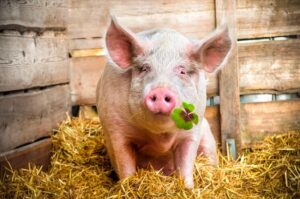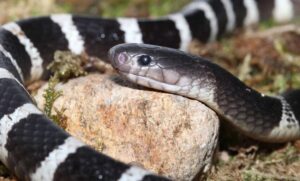Squirrels are rodents, scientifically known as Sciuridae. They include a wide variety of species such as tree squirrels, ground squirrels, and flying squirrels. These animals are a lovely part of nature, yet they are also vulnerable and in urgent need of protection from their “brutal” predators. Let’s learn about some Interesting Facts About Squirrels in the following article from KnowAllAnimals!
1. General Characteristics of Squirrels
Squirrels are generally small animals, with some species being as small as 7 to 10 cm (3 to 4 inches) and weighing about 10 grams (0.35 ounces). The largest species can be 50 to 75 cm (20 to 30 inches) long and weigh about 5 to 8 kg (11 to 18 lbs). Squirrels have slender bodies with bushy tails, along with large eyes and sharp, curved claws.
A squirrel’s fur is mostly soft and smooth, and some species have very thick fur. The color of their fur varies between species, with some being brown, gray, or red. A squirrel’s hind legs are longer than its front legs, and each foot has 4 or 5 toes. The front legs have a thumb, although it is quite small. The soles of a squirrel’s hind feet are soft. Their sharp claws help them grip and climb on tree branches.
A squirrel’s tail has many uses, such as for maintaining body balance, for shelter from the rain and sun, or for keeping warm.
- Common name: Squirrel
- Scientific name: Sciuridae
- Class: Mammal
- Diet: Omnivore
- Size: 12-90 cm (size depends on the species)
- Weight: 0.5-1.8 kg
- IUCN Red List Status: Not ranked
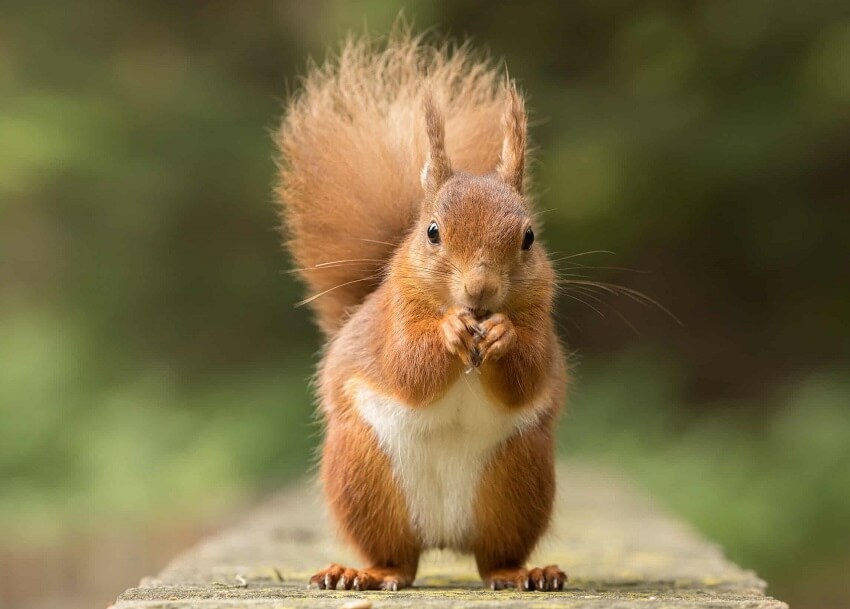
2. Squirrel Classification
A squirrel is a species in the rodent order (Rodentia). Currently, the squirrels that exist on Earth are divided into 5 different subfamilies with about 50 genera and nearly 280 species. There are many different types of squirrels, such as ground squirrels, tree squirrels, chipmunks, golden-mantled squirrels, and flying squirrels. The scaly-tailed flying squirrel in Africa belongs to the family Anomaluridae and is not a true squirrel of the Sciuridae family. Squirrels are found on almost all continents except Australasia and Antarctica.
Some typical squirrel species are as follows:
Flying squirrel: Scientific name: Pteromyini. Flying squirrels cannot truly fly; they glide from tree to tree, with each flight covering about 90 meters (300 ft). Their arms and legs help the squirrel steer and control its speed. In addition to aiding in flight, the squirrel’s tail acts as a brake, helping them land safely.
Rock squirrel: The rock squirrel has a very small body and a bushy tail with gray-brown fur and white spots. This squirrel is often seen in the rocky mountains of New Mexico, Texas, and Arizona. They live along cliffs, in rocky caves, or along highways—anywhere they can find food.
Golden-mantled squirrel: Golden-mantled squirrels live in all the dense forests of North America. They typically forage for food in bushes with berries. Golden-mantled squirrels eat seeds, insects, and mushrooms.
Eastern gray squirrel: The eastern gray squirrel is native to the Midwestern United States and the Eastern and Southern provinces of Canada. They have gray fur, a white belly, and a large, bushy tail.
Red squirrel: The red squirrel is an omnivorous rodent that lives in trees throughout Europe and Asia. The red squirrel, like the gray squirrel, has a white belly, and its sharp, curved claws make it an excellent climber. The red squirrel’s fur changes color depending on its age and location.
Most squirrels in the world are omnivores, and their primary diet consists of seeds and nuts. But many tropical species also eat insects and small vertebrates.
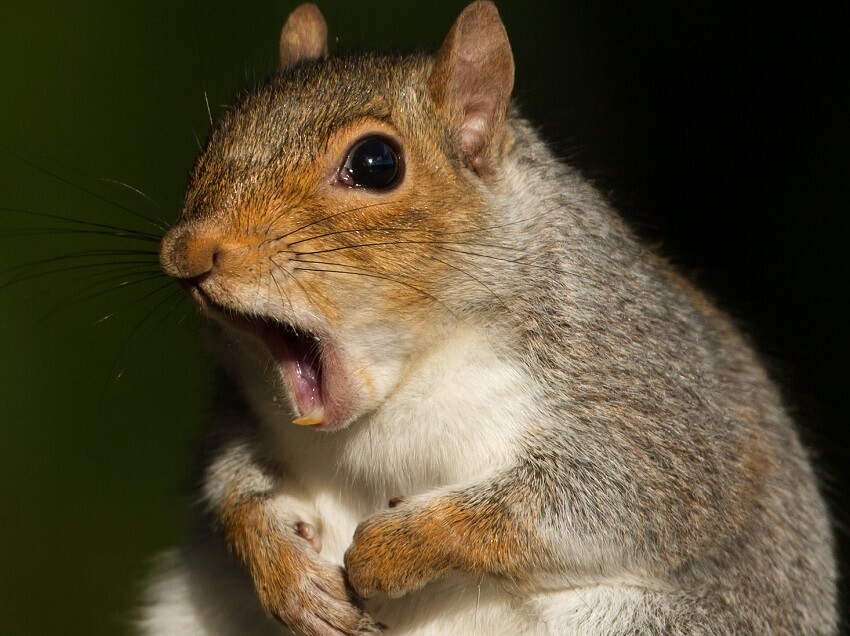
3. 10 Interesting Facts About Squirrels: Nature’s Clever Little Creatures
Squirrels are one of the smallest but most intelligent and agile animals in the natural world. With their ability to remember where they’ve stored food, their agility when climbing, and their fascinating life habits, squirrels have amazed many scientists and animal lovers. Let’s discover 10 interesting facts about squirrels, these tiny but clever creatures.
3.1. The Differences Between Squirrel Species
The smallest squirrel species in the world is the African Pygmy Squirrel, which, from nose to tail, measures only 13 cm (5 inches). In contrast, the Indian Giant Squirrel can reach up to 90 cm (35 inches).
Like other rodents, a squirrel’s four front teeth never stop growing, which forces them to gnaw constantly. The tree squirrel is the most recognizable type of squirrel; it is often seen leaping from branch to branch. Another type of squirrel is the ground squirrel, which lives in burrows or tunnel systems underground.
The ground squirrel’s diet consists of nuts, leaves, roots, seeds, and some other plants. They also eat small animals such as insects and caterpillars. These small squirrels must always be on alert for predators because they are almost defenseless. Sometimes, ground squirrels work together in colonies, whistling to warn each other of danger.
Then there’s the tree squirrel, which lives everywhere, from remote mountain forests to city parks. Although this species is very good at climbing trees, they also often jump to the ground to forage for food like nuts, acorns, berries, and flowers. Their diet also includes tree bark, eggs, or young birds. Tree sap is also a favorite food for some species.
The third type of squirrel is the flying squirrel—the most adaptable species. Like birds, flying squirrels live in nests or tree hollows. Although they cannot fly, these squirrels can leap very far. When moving between branches and trees, a flying squirrel spreads out its limbs. It then quickly jumps from one tree to another. The skin connecting its limbs to its body acts like wings. In a single jump, a flying squirrel can glide as far as 45 meters (148 feet). In addition to nuts and fruits, they also eat insects and even young birds.
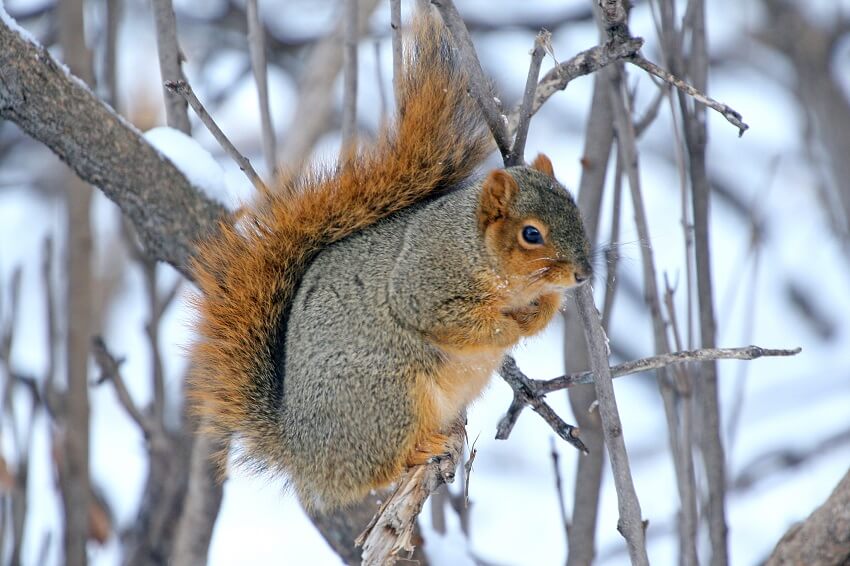
3.2. Physical Appearance
The squirrel family generally consists of small animals, ranging in size from the tiny African pygmy squirrel, which is about 12–14 cm (5-5.5 inches) long and weighs only 15–18 g (0.5-0.6 ounces), to the large Indian giant squirrel, which has a head and body length of 25–50 cm (10-20 inches), a tail of a similar or slightly longer length, and a weight of 1.5–2 kg (3.3-4.4 lbs), though they can rarely reach up to 3 kg (6.6 lbs). The squirrel family generally has a slender body with a bushy tail and large eyes. Their fur is generally soft and smooth, although it can be thicker in some species. The color of their fur varies greatly between species and even within a single species.
The hind legs are generally longer than the front legs, with each foot having 4 or 5 toes. The front paws have a thumb, although it is poorly developed. The feet also have soft pads on the underside.
The squirrel family lives in almost every habitat, from tropical rainforests to semi-arid deserts, with the exception of subarctic regions and the driest deserts. They are primarily herbivores, with a diet of seeds and nuts, but many species also eat insects and even small vertebrates. In fact, some tropical species feed almost entirely on insects. The teeth of squirrels follow the typical rodent tooth structure, with large incisors for gnawing that grow throughout their lives, while their molars for chewing are separated from the incisors by a large gap.
Squirrels generally have good eyesight, which is especially important for arboreal species. Many species also have a sensory system with whiskers or hairs on their feet.
The squirrel family reproduces 1 to 2 times a year, with the number of offspring varying after a 3-6 week gestation period, depending on the species. The young are born naked, toothless, blind, and helpless. In most species, only the mother cares for the young. They are nursed for about 6-10 weeks and become sexually mature by the end of their first year. Ground-dwelling species are generally social and live in colonies, but arboreal species are mostly solitary.
3.3. Squirrel’s Diet and Reproduction
Squirrels are primarily herbivores, with a diet of seeds and nuts, but many species also eat insects and even small vertebrates. In fact, some tropical species feed almost exclusively on insects. The teeth of squirrels follow the typical rodent tooth structure, with large incisors for gnawing that grow throughout their lives, while their molars for chewing are separated from the incisors by a large gap.
Squirrels generally have good eyesight, which is especially important for arboreal species. Many species also have a sensory system with whiskers or hairs on their feet.
Most squirrel species reproduce one to two times a year, with the number of offspring varying after a 3-6 week gestation period, depending on the species. The young are born naked, toothless, blind, and helpless. In most species, only the mother cares for the young. They are nursed for about 6-10 weeks and become sexually mature by the end of their first year. Ground-dwelling species are generally social and live in colonies, but arboreal species are mostly solitary.
If the nest is threatened by predators or disturbed by humans, the mother squirrel will quickly move her young to a safe location, and then build a new nest.
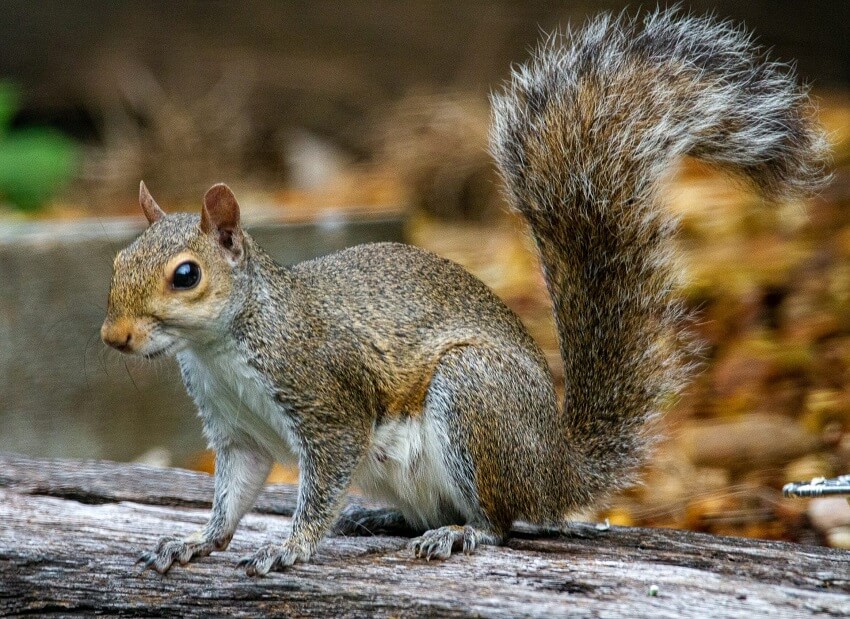
3.4. Flying Squirrels Can Glide up to 90m
The Southern Flying Squirrel (Glaucomys volans) has no wings but can glide through the air like a skilled glider. This spectacular sight is rarely seen, as flying squirrels are only active at night.
During the day, flying squirrels hide in burrows or in nests in trees. They sometimes take over the nests of tree squirrels, woodpeckers, or other birds to make a “home” for themselves. Inside the nest, flying squirrels use soft bark, moss, lichen, and fur to make a cozy bed.
For this species, the mating season occurs from February to March. After a gestation period of about 40 days, the female can give birth to a litter of 2 to 6 pups in the warm nest. The young are nursed for 10 weeks and must reach a certain size before they can glide from tree to tree.
An adult male has an average body length of about 25cm (10 inches), a tail length of about 12cm (5 inches), and weighs about 79 grams (2.8 ounces). The flying squirrel can glide as far as 90m (300 ft) in a single flight. Its “gliding wings” are just skin membranes. When gliding, they extend all four limbs to leap, spreading their patagium (a skin membrane that connects from the wrist to the ankle). Flying squirrels typically forage in the treetops for fruit, bark, lichen, and mushrooms. They only launch themselves into the air when an owl or other predator appears and threatens them.
Flying squirrels also eat insects, bird eggs, and small animals. If they are not raising young, they usually live alone in a nest. However, many flying squirrels often gather in large groups in areas with abundant food. In the fall, they store food in tree hollows for the winter. When winter comes, although they don’t hibernate, they become less active.
3.5. Squirrels Use Shed Snake Skin to Fool Predators
A researcher at the University of California, Davis, discovered an interesting fact: squirrels use shed snake skin to fool their predators. According to a recent UC Davis study, California ground squirrels and rock squirrels know how to cleverly deceive their enemies by chewing on rattlesnake skin and then rubbing it on their fur.
Barbara Clucas, a UC Davis graduate student in animal behavior, observed the ground squirrels and rock squirrels as they created a snake-like scent on themselves by picking up dry pieces of snake skin, chewing them, and rubbing them on their fur.
Clucas said that adult female squirrels and their young use this trick more often than adult males because rattlesnakes have a harder time “bullying” experienced adult male squirrels. The snake scent helps the squirrels mask their own smell, especially when they are sleeping at night, or to signal, “Hey, there’s a snake in this burrow.”
Squirrels not only use dry snake skin; they also take the scent from the soil or from places where snakes have rested and use those things to create a scent. Other rodents have similar behaviors. A squirrel’s use of a snake’s scent is one of its cleverest defense mechanisms against its rattlesnake opponent. A squirrel can also heat its tail to send a warning signal to the rattlesnake—which can see in infrared—assess the snake’s danger level by the sound it makes, and stand its ground to deter the snake from attacking.
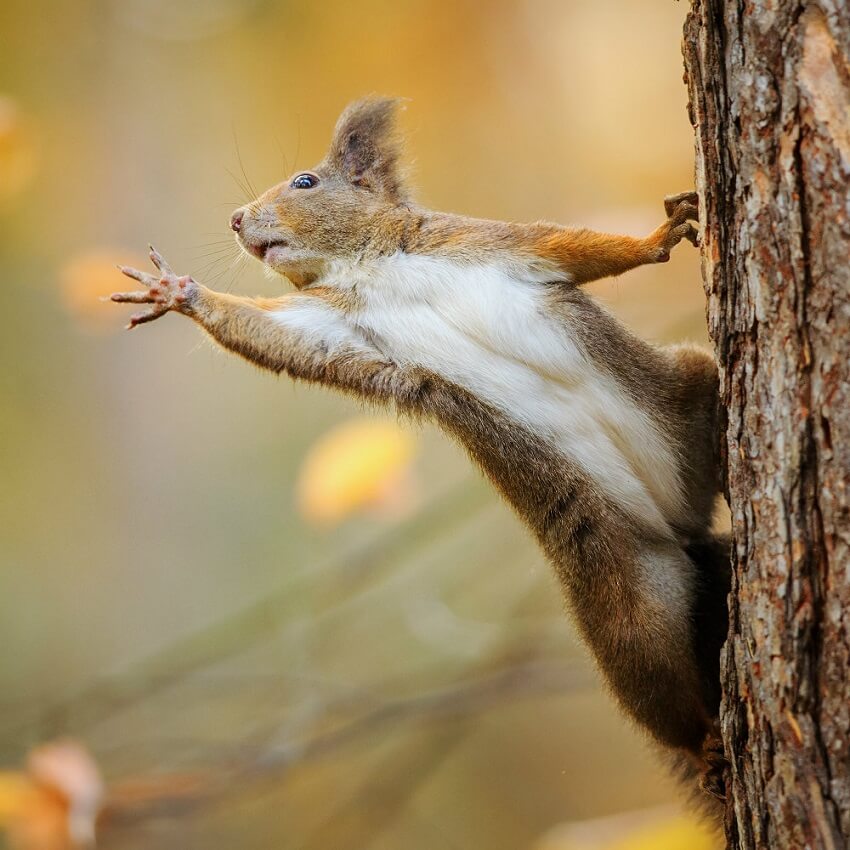
3.6. Red Squirrels Are Near Extinction
According to a recent study by British scientists, the Red Squirrel will be extinct in the next 20 years. According to research from the University of Oxford, the population of red squirrels has decreased by more than 50% in the last 50 years due to rapid urban development, a failed government conservation effort, and a competition with the gray squirrel. In just 20 more years, we will no longer be able to see them.
The Eurasian Red Squirrel is an omnivore that lives in trees and belongs to the genus Sciurus. Red squirrels have a body length of 19-23cm (7.5-9 inches) and weigh about 250-340g (8.8-12 ounces).
In addition to the red squirrel, the European hedgehog, dormouse, hare, and wildcat are also on the endangered species list. The European hedgehog population has decreased dramatically from 30 million individuals in the 1950s to 15 million, according to a report by the WildCRU (Wildlife Conservation Research Unit) at the University of Oxford.
Although many of Britain’s mammals have decreased significantly in the last 25 years, some other species have stabilized or even increased in the last decade, such as hamsters and otters.
3.7. Squirrels Can Be Toxic
As with other wild game, the consumption of a squirrel that has been exposed to high levels of pollution or toxic waste poses a health risk to humans. In 2007, in the New Jersey community of Ringwood, the New Jersey Department of Health issued a warning for anyone eating squirrels (especially for children and pregnant women) to limit their consumption after a squirrel contaminated with lead was found near the Ringwood Mines landfill.
Toxic waste had been illegally dumped at this site for many years before authorities cracked down on the practice in the 1980s. Hunting and eating squirrels are considered a long-standing tradition of many indigenous peoples.
In 1997, doctors in Kentucky warned of the potential dangers of eating squirrel brains, which are considered a local delicacy. In the western part of the state, doctors found a very high incidence of Creutzfeldt-Jakob disease, a rare but serious disorder that causes dementia and ultimately death. The so-called “mad squirrel disease” can be difficult to distinguish from a squirrel’s normal behavior, but it may be more common in animals that have been run over on the road. Some people who eat squirrels have special rituals to prepare and eat the brains, while others avoid eating them altogether.
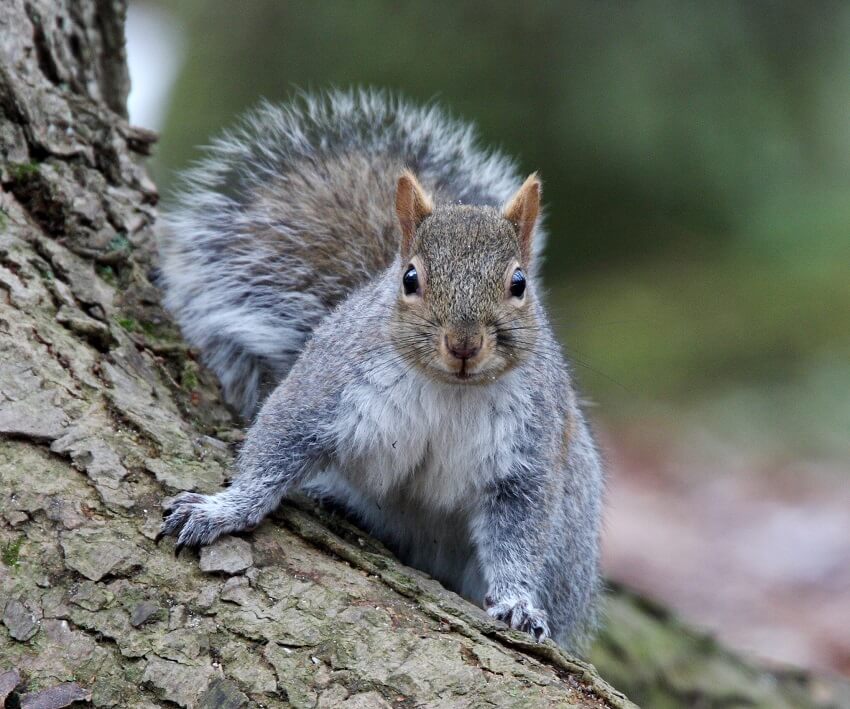
3.8. Contraception for Gray Squirrels
Scientists in the U.S. want to use contraceptive-laced seeds to curb the rapid reproduction of gray squirrels, a rodent species with a habit of destroying trees and crops. Due to increasingly warm winters and an abundance of acorns, people in many U.S. states are seeing an explosion in the number of gray squirrels. Despite their cute appearance, gray squirrels are actually fearsome pests. They destroy food crops on farms, chew on electrical wires, and strip bark from trees.
To stop the population explosion of gray squirrels, controlling their reproductive activity is the most optimal solution. But gray squirrels will not voluntarily take contraception. Even if they were willing to take contraception, the pills currently available are too large for them to swallow.
Scientists have two options. They can use a vaccine to stop the production of sex hormones in squirrels, or they can reduce the cholesterol levels in their bodies. Cholesterol is what produces sex hormones. The big advantage of using a vaccine is that one shot can be effective for many years. However, catching and injecting squirrels is extremely difficult.
Before proposing the idea of using DiazaCon, a team of experts had been studying its effects on gray squirrels for almost 10 years. They lost over 100 trees to the squirrels’ habit of stripping bark and spent over a million dollars planting, caring for, and felling trees that died because of the squirrels. The scientists began lacing black sunflower seeds—one of the gray squirrel’s favorite foods—with DiazaCon at 16 locations where squirrels were often seen on the Clemson University campus.
The black sunflower seeds turned pink from the drug, but the squirrels didn’t seem to mind. The researchers will continue to throw out the drug-laced black sunflower seeds for the next year. During this time, they will monitor the gray squirrels’ behavior and reproductive activity to assess the effectiveness of the DiazaCon. They will also look into whether the drug has any side effects on the squirrels and the predators that eat them.
3.9. Top 4 Endangered Squirrel Species
The Red List of Vietnamese animals includes species that are on the Red Book of Vietnam at different threat levels. Among them are animal species that are only found in Vietnam and nowhere else in the world. Below are the squirrel species that are at risk of extinction in Vietnam and around the world.
Hairy-footed flying squirrel: The hairy-footed flying squirrel, scientific name Belomys pearsonii, is a mammal in the squirrel family, rodent order. It was described by Gray in 1842.
Small flying squirrel: The small flying squirrel, also known as the Indochinese flying squirrel or Phayre’s flying squirrel, scientific name Hylopetes phayrei, is a mammal in the squirrel family, rodent order, distributed in China, Laos, Myanmar, Thailand, and Vietnam. It was described by Blyth in 1859.
Spotted giant flying squirrel: The spotted giant flying squirrel (Petaurista elegans) is a rodent in the squirrel family. This species is distributed in China, India, Indonesia, Laos, Malaysia, Myanmar, Nepal, and Vietnam.
Black giant squirrel: The black giant squirrel, scientific name Ratufa bicolor, is a tree squirrel in the genus Ratufa. It is found in the forests of northern Bangladesh, northeastern India, eastern Nepal, Bhutan, southern China, Myanmar, Laos, Thailand, Malaysia, Cambodia, Vietnam, and western Indonesia.
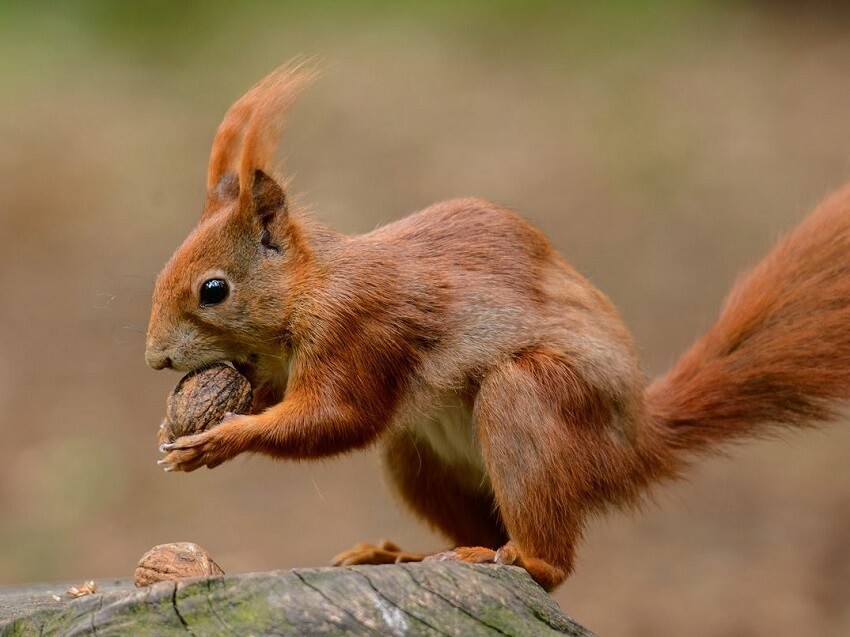
3.10. Other Interesting Facts About Squirrels
Here are some interesting facts about squirrels:
In Greek, the word “squirrel” means “shadow tail.”
A squirrel’s most characteristic behavior is burying nuts and acorns for the winter. This is a necessary practice, as squirrels do not hibernate.
A squirrel’s hind legs have flexible joints, which allow them to climb up and down trees very quickly.
A male squirrel can smell a female squirrel from a mile away (1.6 km).
The squirrel mating season starts from February to May, and the gestation period is 44 days. A mother squirrel will give birth to 2-4 pups per litter.
A squirrel’s front feet have four extremely sharp claws that are used to firmly grip tree bark whenever they climb. Each of their feet also has five separate toes.
In addition to living mainly in the Eastern U.S., the Eastern gray squirrel can also be found in many Western states, the U.K., Ireland, and South Africa.
With 285 diverse species, squirrels can be found on every continent except Antarctica and Australia.
Squirrels can eat an amount of food equal to their body weight each week, which is about 1.5 pounds (0.8 kg).
Squirrels can fall from a height of 30 meters (100 ft) without being harmed.
When jumping or falling from a height, a squirrel will use its tail for balance and as a parachute!
The Arctic ground squirrel (a ground squirrel species native to the Arctic) is the only mammal that can withstand freezing during hibernation.
A squirrel’s eyes are positioned on the side of its head, which allows them to see things behind their back.
In 2007, Iran claimed that 14 squirrels found near its border were actually “spy squirrels.”
In 2013, authorities closed a campground in the Los Angeles National Forest when they found a squirrel infected with the plague. The infected squirrel killed a 15-year-old boy from Kyrgyzstan when he tried to catch it. More than 100 people had to be quarantined because they were suspected of having come into contact with the infected squirrel.
Squirrels are extremely intelligent animals and can learn to navigate through many obstacles to find the shortest path to food. They are also quite good at finding shortcuts.
Squirrels can jump up to 20 feet (6m). They have two long, strong hind legs that work in rhythm with their two short front legs to make their leaps.
In the 2005 remake of “Charlie and the Chocolate Factory,” the scene where squirrels sort chestnuts was not done with CGI but with real squirrels. They were professionally trained by animal trainer Michael Alexander, whose team spent 19 weeks training the squirrels for this scene.
In 1963, the city of Longview, Washington, had a bridge built for squirrels called Nutty Narrows. This 18-meter (60-ft) bridge has turned the town into the squirrel-loving capital of America. Longview holds a Squirrel Festival every August.
Squirrels have been proven to run at a speed of 30 km/h (18 mph). However, most squirrels only run at half that speed.
The Eurasian Red Squirrel, scientific name Sciurus vulgaris, is an omnivorous tree squirrel in the genus Sciurus, squirrel family, rodent order. It was described by Linnaeus in 1758. They are a common omnivorous tree rodent throughout Eurasia. In Great Britain and Ireland, their numbers have declined sharply in recent years, partly due to the introduction of the Eastern gray squirrel (Sciurus carolinensis) from North America. Recent studies suggest that the population of red squirrels is rapidly decreasing.
This has been some information about Interesting Facts About Squirrels. We hope this article from Know All Animals has brought you a lot of useful information.

